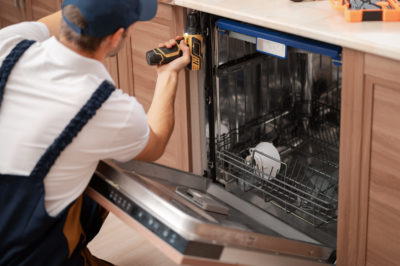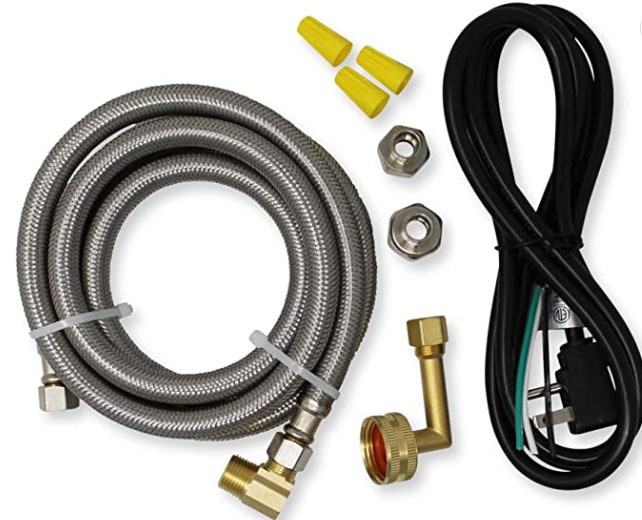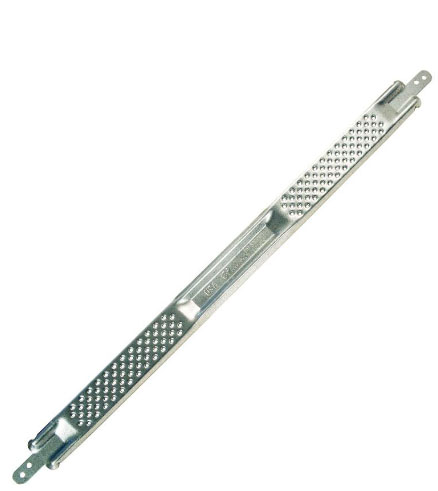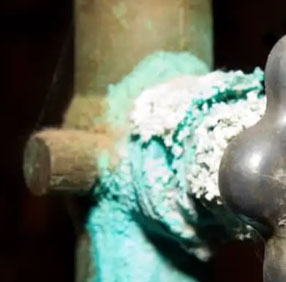Dishwasher Installation
A dishwasher installation normally takes between an hour and an hour-and-a-half. Your technician will arrive and verify with you that the product and color are correct. He will remove your old dishwasher and haul it away if that service was requested.
Some dishwashers are hard-wired directly to your home. Other dishwashers require an outlet.
Your installer will unpackage the unit and will prepare the electrical connection. He will also run the new water lines and drain lines and connect them under your sink and to your dishwasher.
Next, he will move the dishwasher into its space. He will make sure it is level before he mounts the unit. He will then attach the dishwasher to the side cabinet walls or to the under-side of the countertop.
Finally, he will run the dishwasher to make sure it works properly making sure that it drains and will walk you through the basic operation of the appliance.

How do I know if it was installed correctly?
These are a few things to consider:
- Is the unit securely mounted? You should be able to open and close your dishwasher and have it feel securely attached.
- Is the unit level and centered in the space? Your technician should do his best to minimize gaps and make sure that the dishwasher looks square and level. Some cabinet walls or floors are crooked and prevent a perfect installation. If that is the case, the technician will do his best to minimize gaps, etc.
- Does the unit run through the cycles properly and drain? Your technician is normally able to test the unit before he leaves. Sometimes new units have factory defects that do not relate to installation. If your dishwasher is having problems, you can call us and we can usually tell if the issue is related to installation or if it relates to the operation of the dishwasher itself which would require a service company.
- Are there any leaks? Your technician should be checking underneath the dishwasher and underneath the sink while it is running to check for leaks. If you think there is a leak call us immediately. Turn off the water to the dishwasher either under the sink or the main water valve. We will return as quickly as possible to investigate.
Other Considerations
Once you’ve selected the dishwasher you want to buy, there are some important things to know about installation:
- Parts to order with your dishwasher
- Dishwasher mounting brackets
- Extended water lines and drain lines
- Outlet installation
- Leaky or corroded valves
Parts to Order with your Dishwasher
In addition to selling you the dishwasher, most retail stores will also be required to sell you an installation parts kit. This consists of a power cord, ninety-degree elbow fitting, a water line and some fasteners.
It is recommended that you replace your water line and drain hose when you replace your dishwasher. Connecting an old drain hose or water line to your new dishwasher increases the likelihood of leaks or blockage and may decrease the life if your appliance.
Certified technicians carry these parts on their vans if you forget to buy one. These are typically less expensive if you buy them from the retail store when you purchase your dishwasher.

Dishwasher Mounting Brackets
Depending on your kitchen’s configuration, your technician will level and attach your new dishwasher to the cabinets or countertop without extra brackets. However, sometimes a little more support is required.
The dishwasher mounting bracket attaches to the cabinets on both sides of the dishwasher but creates a secure place to allow you to attach the top of your dishwasher to the bracket. This bracket allows your technician to install the dishwasher without drilling into granite, marble or other solid countertops. Your Certified technician carries these in his van and will only use one if necessary. These brackets require an additional charge.


Extended Water Lines or Drain Hoses
Typically, your dishwasher will be located right next to your sink. If that is the case, an extended water line and drain hose are not usually needed.
However, sometimes, the dishwasher is farther from the sink than normal. This is often the case when the sink is on one wall and the dishwasher is located around the corner from the sink with a corner cabinet or lazy susan in-between. Other times, the sink is located on a wall and the dishwasher is located on an island cabinet.
If this is the case, we will not normally be able to use your factory drain line and you will need an extended drain and water line.
Some retail stores offer these extended parts, some do not. Your Certified Customer Service representative will normally ask you the distance between your sink and dishwasher and will alert the technician of the possibility that an extension may be required.
If an extension is needed, your technician will route the extended lines through the back of your cabinets and secure these to the cabinet wall. Extending the drain and water lines will result in additional cost for the parts, installation and warranty.
Leaky or Corroded Valves
Hard-water does a number on your pipes and fittings. Over time, hard-water deposits can prevent you from being able to turn off your water under the sink. Your technician can usually turn off your main water line to allow him to complete your installation. It’s a good idea to know where your main water shut-off is before your technician arrives, just-in-case.
Your technician carries extra fittings and can replace your corroded valve with a new stainless steel, quarter-turn valve that will make it easy for you and your family to turn off the water to the sink and dishwasher if necessary. Replacing and adding valves and fittings is typically an extra charge. Your technician will review that with you when he is in your home.

